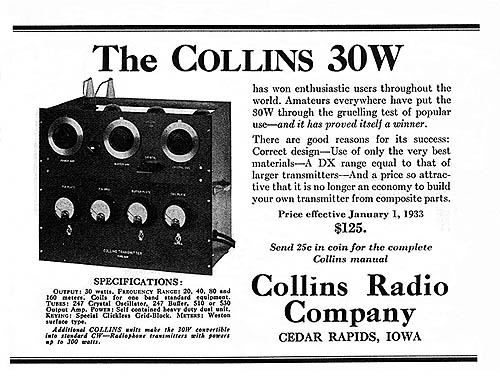30W Transmitter
THE COLLINS 30W TRANSMITTER
The very first assembled and tested Collins transmitter offered to the general amateur community, the 30W was introduced in mid 1932. Based on modular building blocks, the 30W consisted of a 500AX power supply and a 10A RF chassis mounted in a sheet metal frame. An an optional tuner unit was also offered. Each unit had a bakelite front panel attaching to a steel chassis. Although primitive in comparison to later Collins products, the hallmarks of Collins transmitter philosophy were established in its design.
The 30W’s black bakelite panels were crisp and clean with a layout emphasizing convenience. Controls were clearly identified with engraved captions. Its most impressive feature was the row of four Weston model 310 “bug-eye” surface mounted meters adorning the power supply front panel. Above it, a plug-in crystal socket was located on the 10A front panel.
| The 10A Crystal Control unit used a 247 crystal oscillator, a 247 buffer amp, and a 210 output. Three plug-in coils wound on Hammarlund coil forms were used in the oscillator, buffer, and output circuits. A fixed-turn magnetic coupling winding on the output coil was terminated to either the optional antenna coupling unit, or to two white porcelain cone insulators mounted on the rear brace that spanned the top of the frame.The 30W was one of the basic building blocks of the 40B, and the 150A/B transmitters. According to 30W bulletin, it could be converted into one of these larger transmitters merely by adding other units and it was not necessary to discard any of the original equipment.
In July of 1932, the 30W was introduced at a price of $95.60, however, by January of 1933 the price had risen to $125.00. |
- CCA COLLINS HISTORICAL ARCHIVES
- The Pre War Years
- 150 Series Transmitter
- 2A, 2B AND 2C TUNERS (ATU)
- 30FX Transmitter
- 30FXB Transmitter
- 30FXC Transmitter
- 30FXR Transmitter
- 30J Transmitter
- 30W Transmitter
- 32 A/B Transmitter
- 32F Transmitter
- 32G Transmitter
- 40A/B Transmitter
- 45A Transmitter
- 4A Transmitter
- Bulletin 100
- Bulletin 101
- Bulletin 105
- Bulletin 200
- Bulletin 200A
- The Lost Decade
- The War Years
- Post War Broadcast / Commercial
- The Black Boxes
- The Grey Boxes
- The “S” Word or Solid State

